Abstract
The genus Propionibacterium includes cutaneous species typically found on human skin and the dairy or classical species (Propionibacterium freudenreichii, P. jensenii, P. thoenii, and P. acidipropionici) used industrially for the production of Swiss cheese and propionic acid. Grinstead (1989, M.S. thesis, Iowa State University, Ames) has previously observed that some dairy propionibacteria inhibit other species in the classical grouping. We further investigated the inhibitor(s) produced by P. jensenii P126 (ATCC 4872). An antagonist(s) from anaerobic agar cultures of P126 strongly inhibited two closely related strains of propionibacteria, P. acidipropionici P5 and P. jensenii P54, and Lactobacillus bulgaricus NCDO 1489, Lactobacillus delbrueckii subsp. lactis ATCC 4797, Lactococcus cremoris NCDO 799, and Lactococcus lactis subsp. lactis C2. The inhibitor, designated jenseniin G, was active at pH 7.0; inactivated by treatment with pronase E, proteinase K, and type 14 protease; insensitive to catalase; and stable to freezing, cold storage (4 degrees C, 3 days), and heat (100 degrees C, 15 min). Classification of the inhibitor as a bacteriocin is supported by its proteinaceous nature and its bactericidal activity against L. delbrueckii subsp. lactis ATCC 4797. The lack of detectable plasmids suggests a chromosomal location for the determinant(s) of jenseniin G.
Full text
PDF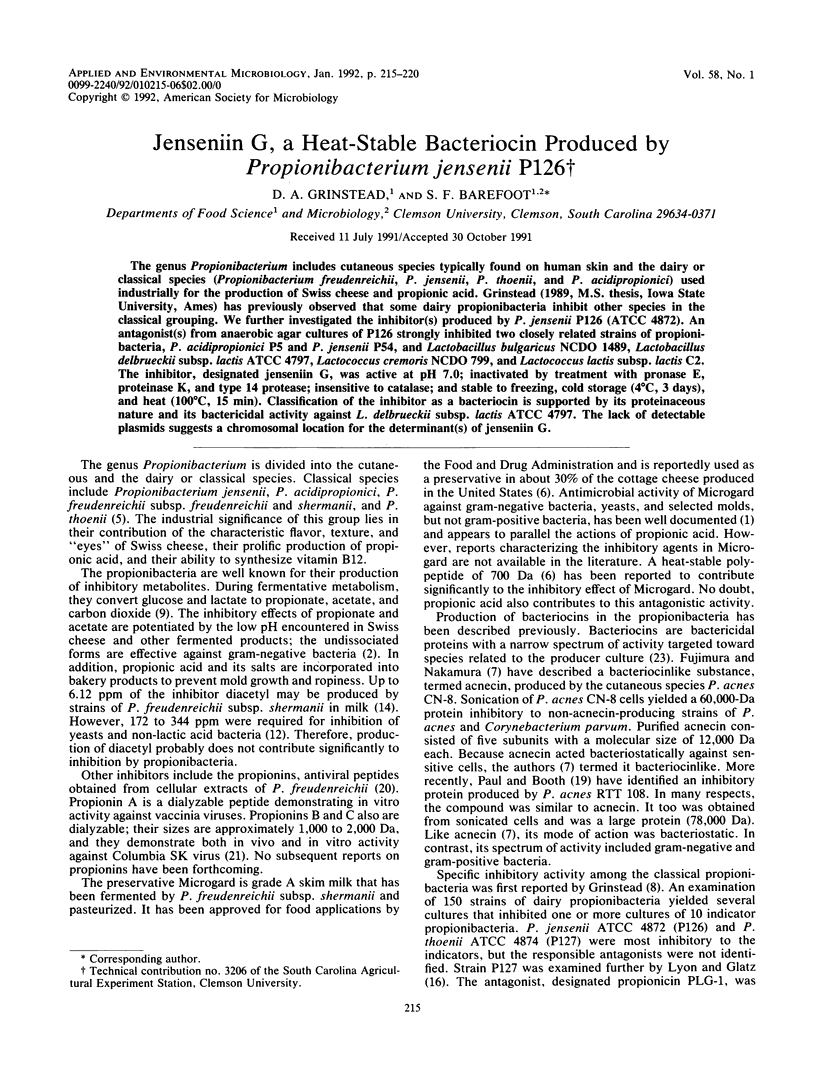
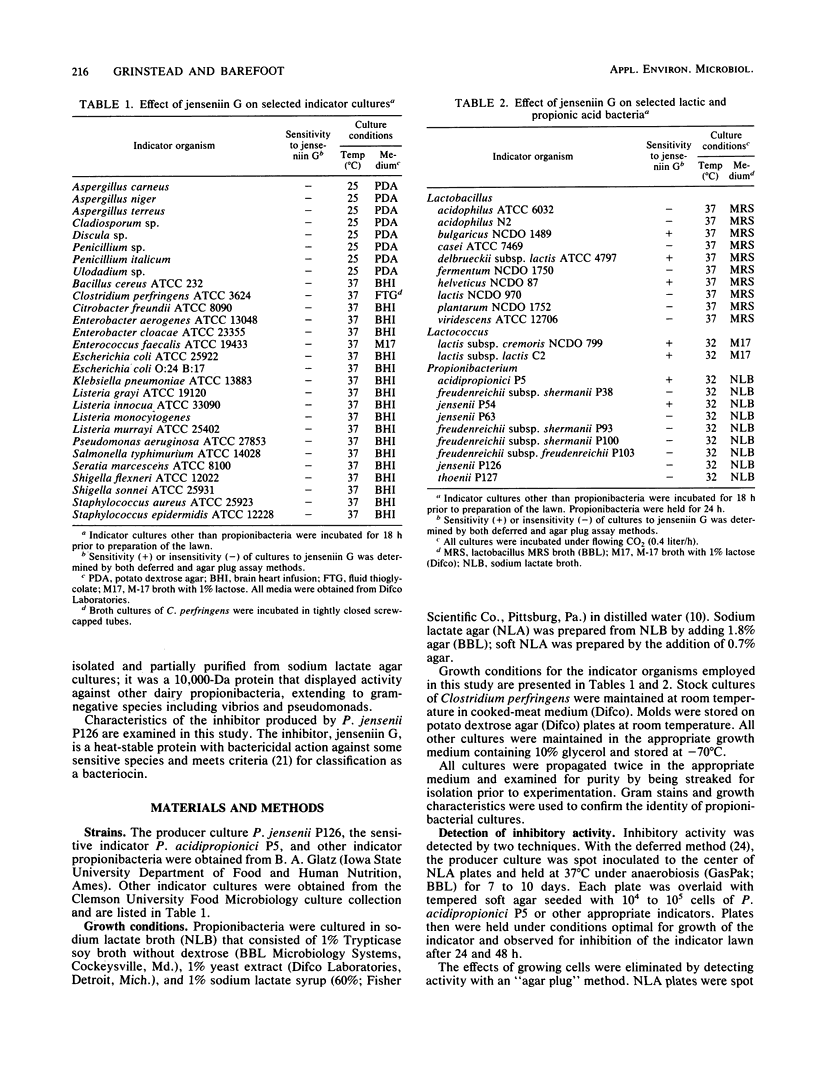
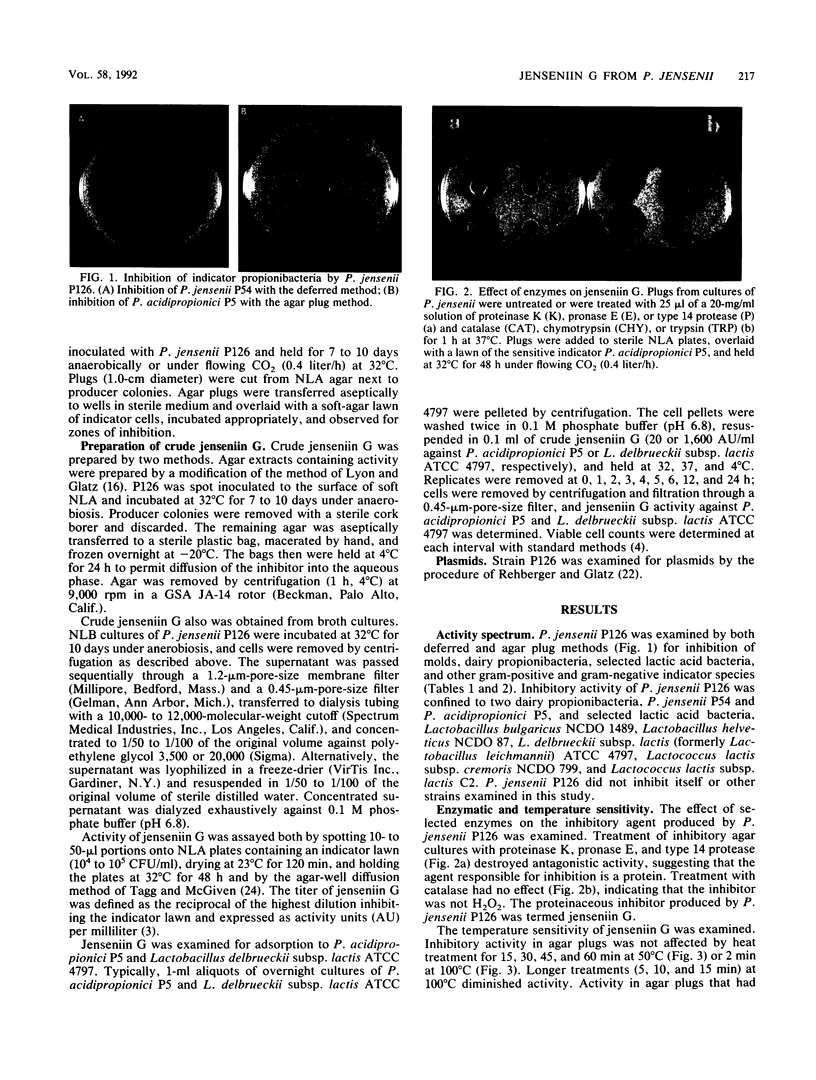
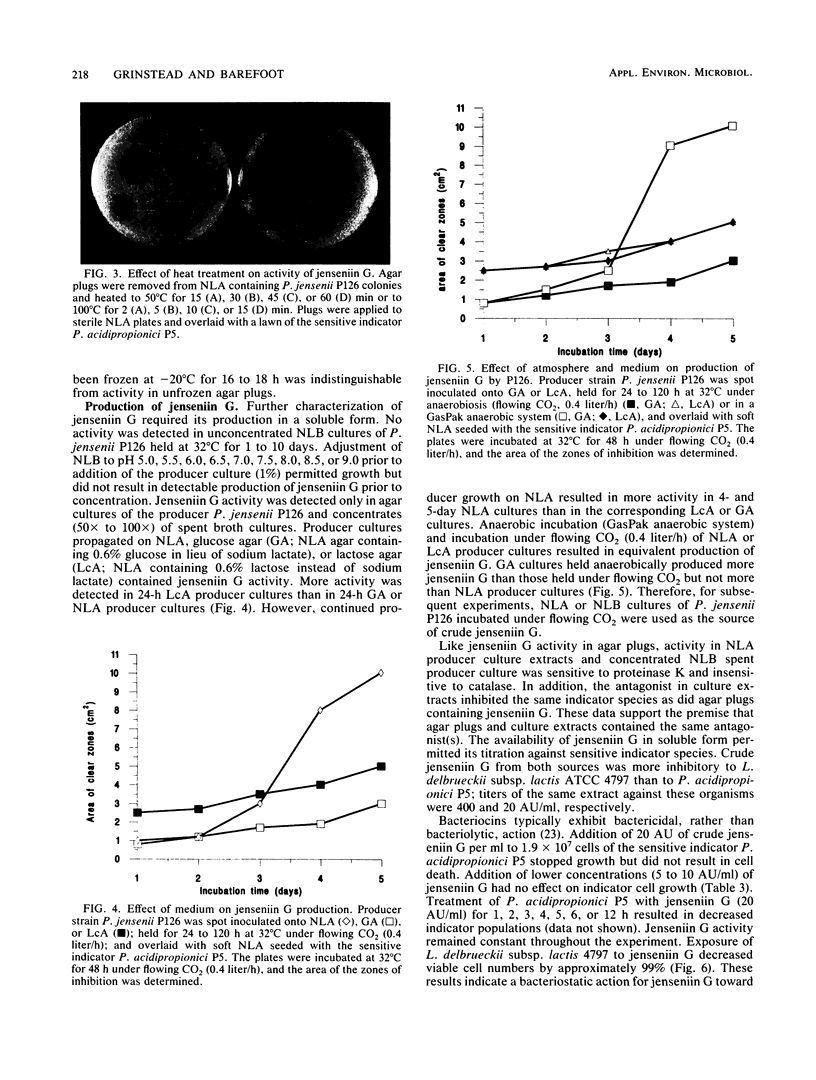
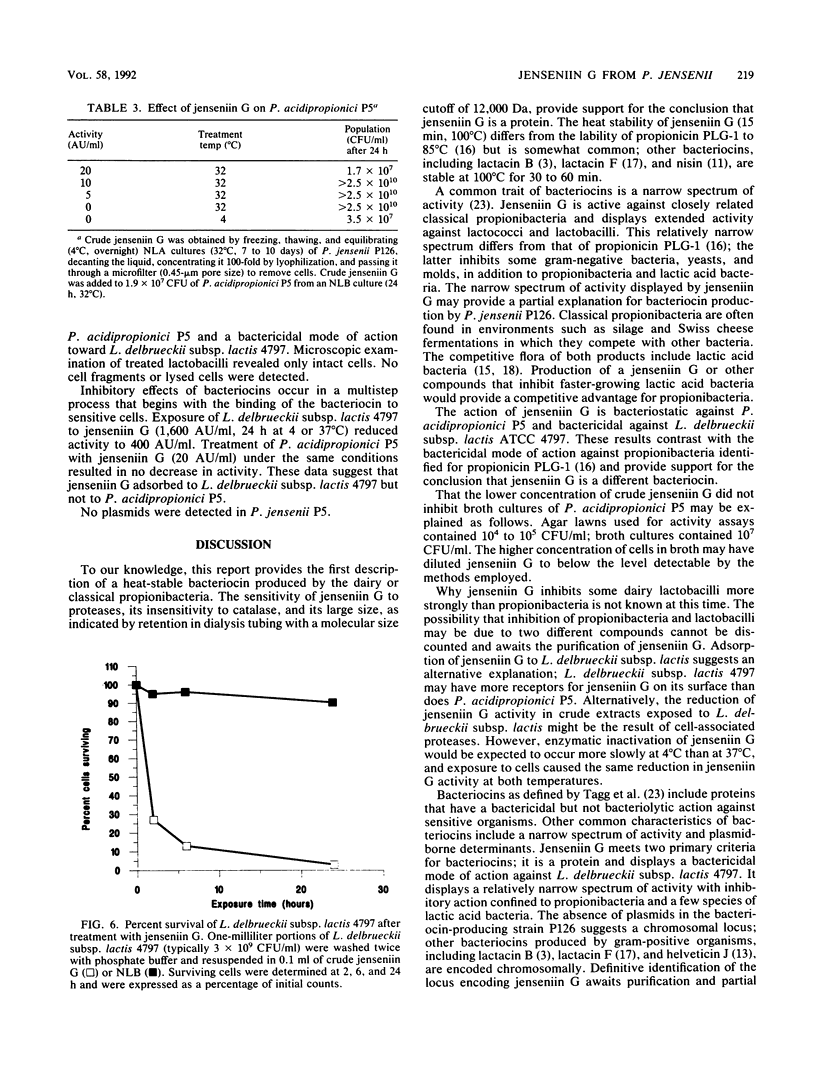
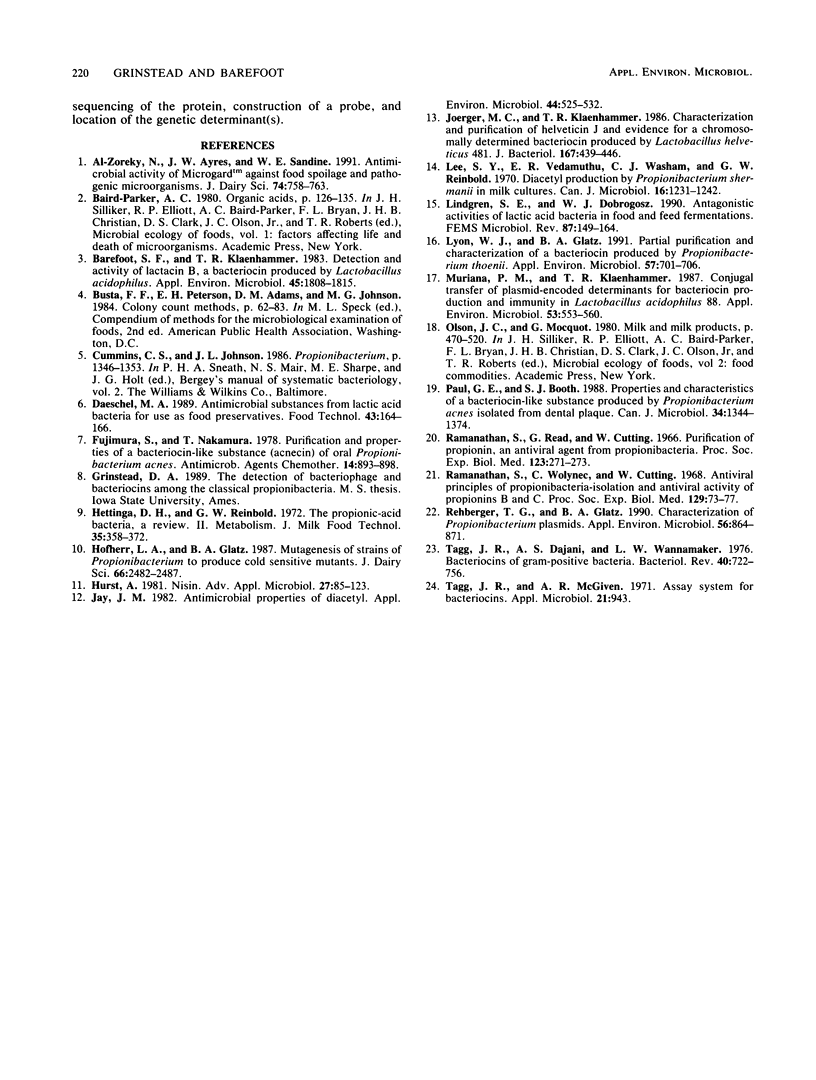
Images in this article
Selected References
These references are in PubMed. This may not be the complete list of references from this article.
- Barefoot S. F., Klaenhammer T. R. Detection and activity of lactacin B, a bacteriocin produced by Lactobacillus acidophilus. Appl Environ Microbiol. 1983 Jun;45(6):1808–1815. doi: 10.1128/aem.45.6.1808-1815.1983. [DOI] [PMC free article] [PubMed] [Google Scholar]
- Fujimura S., Nakamura T. Purification and properties of a bacteriocin-like substance (acnecin) of oral Propionibacterium acnes. Antimicrob Agents Chemother. 1978 Dec;14(6):893–898. doi: 10.1128/aac.14.6.893. [DOI] [PMC free article] [PubMed] [Google Scholar]
- Jay J. M. Antimicrobial properties of diacetyl. Appl Environ Microbiol. 1982 Sep;44(3):525–532. doi: 10.1128/aem.44.3.525-532.1982. [DOI] [PMC free article] [PubMed] [Google Scholar]
- Joerger M. C., Klaenhammer T. R. Characterization and purification of helveticin J and evidence for a chromosomally determined bacteriocin produced by Lactobacillus helveticus 481. J Bacteriol. 1986 Aug;167(2):439–446. doi: 10.1128/jb.167.2.439-446.1986. [DOI] [PMC free article] [PubMed] [Google Scholar]
- Lee S. Y., Vedamuthu E. R., Washam C. J., Reinbold G. W. Diacetyl production by Propionibacterium shermanii in milk cultures. Can J Microbiol. 1970 Dec;16(12):1231–1242. doi: 10.1139/m70-207. [DOI] [PubMed] [Google Scholar]
- Lindgren S. E., Dobrogosz W. J. Antagonistic activities of lactic acid bacteria in food and feed fermentations. FEMS Microbiol Rev. 1990 Sep;7(1-2):149–163. doi: 10.1111/j.1574-6968.1990.tb04885.x. [DOI] [PubMed] [Google Scholar]
- Lyon W. J., Glatz B. A. Partial Purification and Characterization of a Bacteriocin Produced by Propionibacterium thoenii. Appl Environ Microbiol. 1991 Mar;57(3):701–706. doi: 10.1128/aem.57.3.701-706.1991. [DOI] [PMC free article] [PubMed] [Google Scholar]
- Muriana P. M., Klaenhammer T. R. Conjugal Transfer of Plasmid-Encoded Determinants for Bacteriocin Production and Immunity in Lactobacillus acidophilus 88. Appl Environ Microbiol. 1987 Mar;53(3):553–560. doi: 10.1128/aem.53.3.553-560.1987. [DOI] [PMC free article] [PubMed] [Google Scholar]
- Paul G. E., Booth S. J. Properties and characteristics of a bacteriocin-like substance produced by Propionibacterium acnes isolated from dental plaque. Can J Microbiol. 1988 Dec;34(12):1344–1347. doi: 10.1139/m88-236. [DOI] [PubMed] [Google Scholar]
- Ramanathan S., Read G., Cutting W. Purification of propionin, an antiviral agent from Propionibacteria. Proc Soc Exp Biol Med. 1966 Oct;123(1):271–273. doi: 10.3181/00379727-123-31463. [DOI] [PubMed] [Google Scholar]
- Ramanathan S., Wolynec C., Cutting W. Antiviral principles of Propionibacteria-isolation and activity of propionins B and C. Proc Soc Exp Biol Med. 1968 Oct;129(1):73–77. doi: 10.3181/00379727-129-33253. [DOI] [PubMed] [Google Scholar]
- Rehberger T. G., Glatz B. A. Characterization of Propionibacterium plasmids. Appl Environ Microbiol. 1990 Apr;56(4):864–871. doi: 10.1128/aem.56.4.864-871.1990. [DOI] [PMC free article] [PubMed] [Google Scholar]
- Tagg J. R., Dajani A. S., Wannamaker L. W. Bacteriocins of gram-positive bacteria. Bacteriol Rev. 1976 Sep;40(3):722–756. doi: 10.1128/br.40.3.722-756.1976. [DOI] [PMC free article] [PubMed] [Google Scholar]
- Tagg J. R., McGiven A. R. Assay system for bacteriocins. Appl Microbiol. 1971 May;21(5):943–943. doi: 10.1128/am.21.5.943-943.1971. [DOI] [PMC free article] [PubMed] [Google Scholar]
- al-Zoreky N., Ayres J. W., Sandine W. E. Antimicrobial activity of Microgard against food spoilage and pathogenic microorganisms. J Dairy Sci. 1991 Mar;74(3):758–763. doi: 10.3168/jds.S0022-0302(91)78222-2. [DOI] [PubMed] [Google Scholar]





